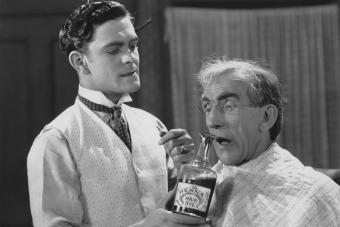
Cristina from decor4home2 Etsy Used by permission of Cristina from decor4home2 Etsy Hemingray 42 Insulators Blue Glass Made in USA Telephone Telegraph/ industrial decor/ industrial bookends
If you collect antique glass insulators, you may encounter the venerable Hemingray-42 telegraph insulator. This recognizable model came in many different colors, some of which are rare and valuable. Learn about the electrifying history of the Hemingray-42, as well as how to identify one you may have found.
History of the Hemingray-42 Insulator
If you've ever driven by old telegraph lines next to a railroad, you may have noticed the glass insulators sparkling at the top of the poles. We think they're pretty, and their history is pretty fascinating, too.
During the era when telegraphs were a primary method of communication, these glass insulators kept the wires from coming into direct contact with the sometimes wet poles. This helped insulate the signal and allowed it to travel across the country. The Hemingray-42 was one of the most common styles of glass insulators. Millions of them were produced between 1921 and 1960. Even today, they are extremely common in antique stores, flea markets, and even garage sales.
How to Identify a Hemingray-42 Glass Insulator
Lucky for collectors, it's easy to identify a Hemingray-42 insulator. The glass is embossed with the name and style number. Both are clearly printed on the insulator. There may be other markings, including numbers, dashes, and dots.
Dates for Hemingray-42 Insulators
The numbers and other markings on an insulator can help you establish a manufacture date for it. After 1933, the company began to include these marks to indicate the production date. You may see the following Hemingray glass marks:
- O - A capital O, sometimes mistaken for a zero, stands for Owens, Illinois, where the insulator was made. This mark was used in 1933 and appeared under the name on the front of the insulator.
- O-4 (and other numbers) - In 1934, the company began adding a digit to represent the year. O-4 means 1934. O-9 means 1939.
- 23-42 (and other numbers) - In 1940, the company realized the single digit year number would no longer work. They began adding a mold number and a year number to the back of the insulator instead. The year number is the second number in the set, so in the case of 23-42, the insulator mold was made in 1942.
- Dots - The dots that appear next to some dates indicate how many years have passed since the mold was produced. For instance, an insulator with the mark 23-42 and two dots would have been manufactured in 1944.
Hemingray-42 Colors
You'll find Hemingray insulators in almost a rainbow of colors. The most common color for Hemingray-42 insulators is "Hemingray blue," a pretty clear teal color that many people associate with glass insulators. However, it is also common to find them in aqua, pale ice blue, clear, and light green. Rarer colors include a deep, clear green, two-tones that happened when glass colors were changed, and very rarely, iridescent carnival glass coatings and milk glass.
Although some people believe that Hemingray-42 insulators came in "ruby red" and you may see these listed on eBay and other sites, the company did not make a pure ruby red insulator. Those sold as "ruby red" may be surface stained or reproduction examples.

Cristina from decor4home2 Etsy Used by permission of Cristina from decor4home2 Etsy Hemingray 42 Insulators Blue Glass Made in USA Telephone Telegraph/ industrial decor/ industrial bookends
Insulator Styles
The Hemingray-42 insulator came in two main styles. In the standard style, the small scallops or "drip points" along the bottom of the skirt are rounded. In a rarer variation, they are sharp points. You'll see both at antique stores.
What Are Hemingray Insulators Worth?
Because the Hemingray-42 insulator is one of the most common, they tend to be an affordable collectible. Most sell for under $10. You'll find them in most insulator collections, but there are certain factors that can make them worth a bit more.
Condition
These are antiques that had a practical purpose, and many glass insulators spent years or even decades outside in the weather. Most have chips, cracks, discoloration, and other damage. So if you find an insulator in pristine condition, it may be worth more.
Rarity
While Hemingray blue is beautiful, insulators in this common color won't fetch much. If you have a Hemingray-42 in a rarer color, such as deep green, it may be worth considerably more. Milk glass insulators are some of the most valuable because of their rarity.
Sample Hemingray-42 Values
To assign a value to a specific insulator, you need to compare it to recently sold models in similar condition. Here are a few sample Hemingray-42 values.
- A rare Hemingray-42 in the uncommon deep, clear green color fetched $87 online. It was in beautiful condition.
- A Hemingray-42 in the common Hemingray blue fetched $46 at auction because it had a unique feature: carbon impurities in the skirt. The black streaks made it rare.
- An aqua Hemingray-42 with all drip points intact sold for about $5.50. It had two small areas of wear on one side.
- A pair of two clear Hemingray-42 insulators without any chips or cracks was less desirable, selling for only two dollars.
Collectibles With Tons of History
If you're considering expanding your collection or simply enjoy learning about this important part of telecommunications history, take a moment to read up on antique glass insulators. There are dozens of brands and many different styles and colors, making collecting insulators a fun and affordable hobby. And if you've found an old insulator in a box in the garage, it doesn't hurt to learn more about it and its potential value.







